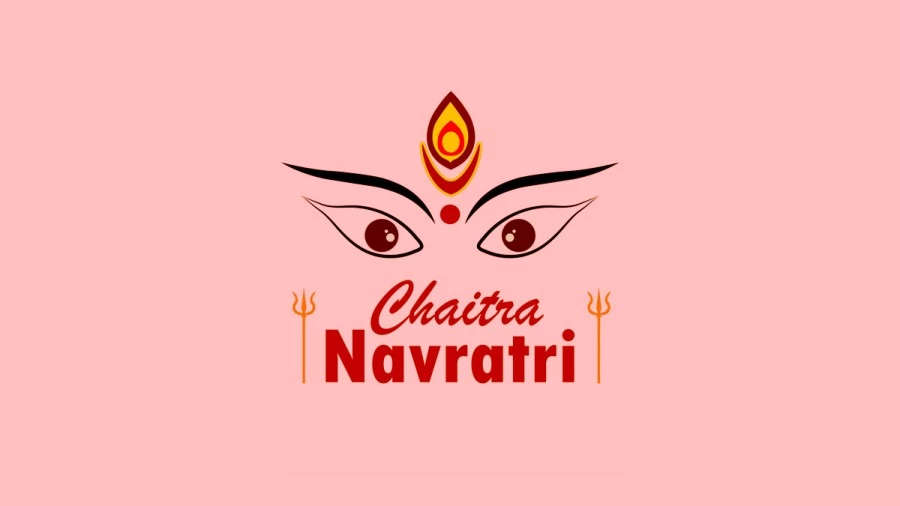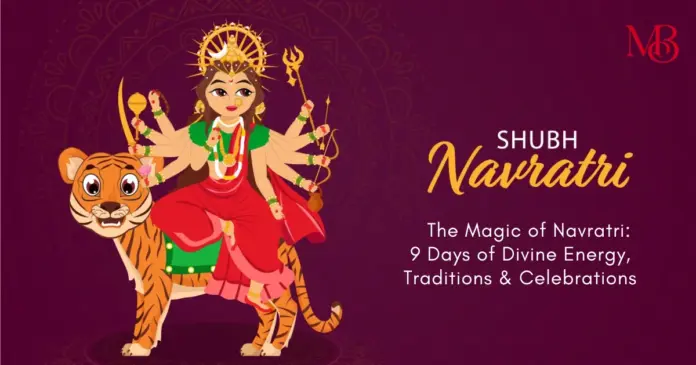Chaitra Navratri is that time of the year when devotion, colors, and festivity take over our hearts. Whether it’s the rhythmic beats of Garba, the aroma of delicious bhog, or the spiritual aura of the 9 days, Navratri holds a special place in Indian culture. But have you ever wondered why is Navratri celebrated and what makes it so significant?
Why is Chaitra Navratri Celebrated?
Chaitra Navratri, which means “nine nights,” is dedicated to Goddess Durga and her nine forms. These days symbolize the victory of good over evil, inspired by the legend of Goddess Durga slaying the demon Mahishasura. It is believed that worshipping the Goddess during these 9 days removes negativity and brings prosperity.
There are actually four types of Navratri celebrated in India: Chaitra Navratri (March-April), Sharad Navratri (September-October), Magha Navratri, and Ashadha Navratri. Among these, Chaitra Navratri and Sharad Navratri are the most significant.

The Story Behind Chaitra Navratri
The most popular legend associated with Navratri is that of Goddess Durga’s battle against Mahishasura. Mahishasura was a powerful demon who, after receiving a boon from Lord Brahma, believed he was invincible. He terrorized the heavens and the earth, causing chaos. The gods, unable to defeat him, sought help from Goddess Durga, who fought Mahishasura for nine days and nights before finally slaying him on the tenth day. This victory is celebrated as Vijayadashami or Dussehra in many parts of India.
Navratri is also linked to the Ramayana, as Lord Rama is believed to have worshipped Goddess Durga for nine days before defeating Ravana on the tenth day, marking the occasion of Dussehra.
9 Days of Chaitra Navratri Devi Names & Significance
Each day of Navratri is dedicated to a different form of Goddess Durga. Here’s a quick look at Navratri Day 1 to 9 Goddess names and their significance:
| Day | Goddess | Symbolism |
| Day 1 | Shailputri | Goddess of nature and strength |
| Day 2 | Brahmacharini | The symbol of penance and devotion |
| Day 3 | Chandraghanta | Warrior goddess, brings peace and bravery |
| Day 4 | Kushmanda | Bestower of health and wealth |
| Day 5 | Skandamata | Mother of Lord Kartikeya, represents motherly love |
| Day 6 | Katyayani | The fierce form of Durga, slayer of demons |
| Day 7 | Kaalratri | Destroyer of darkness and evil |
| Day 8 | Mahagauri | Symbolizes purity and serenity |
| Day 9 | Siddhidatri | Grants wisdom and supernatural powers |
The Colors of Navratri
Each day of Navratri is associated with a specific color, which holds spiritual significance. Devotees wear these colors to align with the divine energy of the Goddess.
| Day | Color | Meaning |
| Day 1 | Red | Energy and passion |
| Day 2 | Royal Blue | Tranquility and power |
| Day 3 | Yellow | Happiness and brightness |
| Day 4 | Green | Prosperity and fertility |
| Day 5 | Grey | Strength and transformation |
| Day 6 | Orange | Courage and enthusiasm |
| Day 7 | White | Peace and purity |
| Day 8 | Pink | Love and harmony |
| Day 9 | Purple | Spirituality and wisdom |
Bhog for Navratri 2025: What to Offer Each Day
Food plays a crucial role in Navratri rituals. Each day is associated with a special bhog (prasad) offered to the Goddess. Here’s what you can prepare for Bhog Navratri 2025:
- Day 1: Ghee and sweets
- Day 2: Sugar or jaggery
- Day 3: Milk and milk-based sweets
- Day 4: Malpua
- Day 5: Banana or honey
- Day 6: Offerings made of jaggery
- Day 7: Jaggery or coconut
- Day 8: Halwa, puri, and chana (Ashtami bhog)
- Day 9: Fruits and kheer (Navami bhog)
Chaitra Navratri 2025 & 2nd Navratri 2025: Dates to Remember
- Chaitra Navratri 2025 will begin on March 30, 2025, and end on April 7, 2025.
- The 2nd Navratri 2025 (Sharad Navratri) is expected to start on September 25, 2025, and conclude on October 3, 2025.
Mark your calendars to celebrate these divine days with full enthusiasm!
10 Points on Navratri: Interesting Facts
- Navratri is one of the longest Hindu festivals, lasting nine nights.
- It is celebrated in different ways across India – Garba in Gujarat, Durga Puja in Bengal, and Ram Navami in North India.
- Fasting during Navratri detoxifies the body and boosts immunity.
- Each day has a specific color associated with it, influencing clothing choices.
- The festival is dedicated to the Tridevi – Durga, Lakshmi, and Saraswati.
- Garba and Dandiya are popular dance forms performed during Navratri.
- The final day of Navratri is celebrated as Ram Navami in Chaitra Navratri and Vijayadashami (Dussehra) in Sharad Navratri.
- Many devotees walk barefoot to temples during these days.
- The Kanya Pujan ritual (worshipping young girls) symbolizes honoring the feminine divine.
- Temples in India witness massive footfall during Navratri, making it one of the busiest festive seasons.
You might also like: Navratri 2025: Celebrating Diversity, Fasting, and Traditions in India
Navratri is not just about rituals; it’s about embracing positivity and celebrating divine energy. Whether you’re fasting, playing Garba, or simply soaking in the festive vibes, these 9 days are a reminder of the power of faith and devotion.
You might also like: The Magic of Navratri: 9 Days of Divine Energy, Traditions & Celebrations
How do you celebrate Navratri? Do you have a special tradition that makes it unique for you? Share your thoughts in the comments below! Jai Mata Di!
FAQs About Navratri
1. Can non-vegetarians eat meat during Navratri?
Most devotees abstain from meat, alcohol, and even onion and garlic during Navratri. However, it depends on personal beliefs and traditions.
2. What is the significance of fasting during Navratri?
Fasting is believed to detoxify the body and enhance spiritual energy. It also symbolizes self-discipline and devotion.
3. Why do people play Garba and Dandiya during Navratri?
Garba and Dandiya symbolize the cosmic dance of the Goddess and celebrate the victory of good over evil.
4. What happens on the 10th day of Navratri?
The 10th day, known as Dussehra, marks the victory of Goddess Durga over Mahishasura or Lord Rama’s victory over Ravana.


